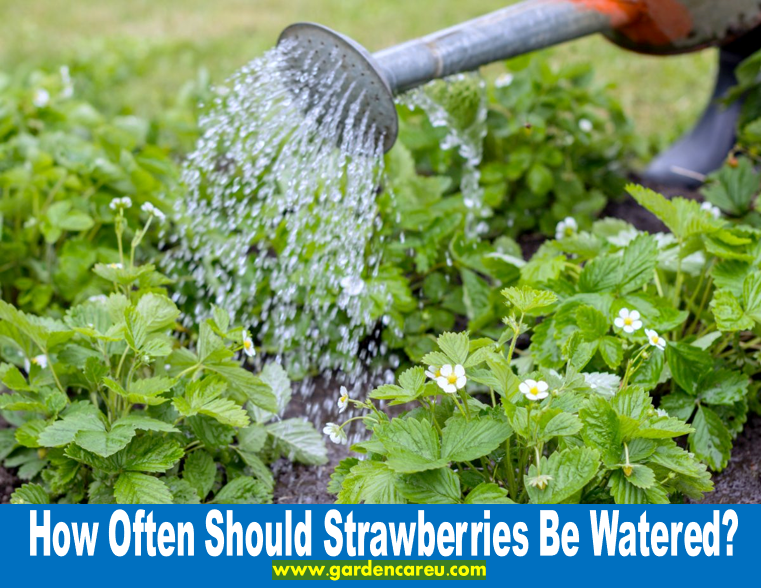How Often Should Strawberries Be Watered? Strawberries should be watered once every week to avoid drowning roots, and overwatering can harm the plants.
Proper watering is essential for the health and growth of strawberry plants. Maintaining a consistent watering schedule is crucial to prevent root damage. Adequate hydration is vital, but excess moisture can lead to root rot. Understanding the specific needs of strawberry plants and recognizing the signs of overwatering or underwatering can help you maintain a healthy garden.
By following the recommended watering frequency, you can ensure that your strawberries thrive and produce bountiful harvests. If you are unsure how often to water your strawberry plants, this guide will provide the necessary information to support their growth and development efficiently.
[ez-toc]
Importance Of Proper Watering
Strawberries are delicate plants that require a consistent and appropriate amount of water to thrive and produce fruit. Proper watering is crucial for their growth and development. It affects strawberry plants’ overall health, fruit quality, and yield. Adequate hydration is essential to ensure their survival and productivity.
Effects Of Overwatering
Overwatering can lead to root rot and fungal diseases, causing the strawberry plants’ roots to become waterlogged and suffocate. This can hamper nutrient uptake and create an environment conducive to pathogen growth, ultimately stunting the plant’s growth and reducing fruit production.
Consequences Of Underwatering
Conversely, underwatering can lead to dehydration and wilting of the plants, affecting their ability to produce healthy and robust fruit. Lack of sufficient moisture can also result in reduced flowering and fruiting, ultimately impacting the yield of strawberries.
Understanding Strawberry Watering Needs
Balancing moisture for strawberry plants is crucial for their health.
- Soil type impacts drainage, affecting how often strawberries need water.
- Temperature and humidity levels influence the rate of soil moisture evaporation.
- The size and stage of plant growth determine the water requirements of strawberries.
Strawberries thrive in well-drained, moist soil conditions.
| Soil Moisture Level | Watering Frequency |
|---|---|
| Too Dry | Water strawberries appropriately to prevent stress. |
| Optimal Moisture | Maintain consistent moisture with regular, deep watering. |
| Overly Wet | Avoid waterlogging by adjusting watering frequency and drainage. |
Properly gauging the soil moisture is key to ensuring healthy strawberry growth.
Best Practices For Watering Strawberries
To ensure healthy strawberry plants, it is recommended that they be watered once a week during the non-peak growing season. It is best to water earlier in the day to keep the soil moist and avoid overwatering.
Establishing A Watering Schedule
Establishing a consistent watering schedule is crucial when it comes to watering strawberries. By providing your strawberry plants with the right amount of water at the right times, you can help them thrive and produce delicious, juicy berries.
So, how often should strawberries be watered? The watering frequency will depend on various factors, including the weather, soil conditions, and the growth stage of your strawberry plants. As a general guideline, during the non-peak growing season, watering twice a week is usually sufficient to keep the soil moist and the plants hydrated.
Methods For Watering Strawberries
Several methods are available to effectively water your strawberry plants. The right method will depend on factors such as your garden setup, time availability, and personal preferences.
1. Hand Watering
The most traditional and straightforward method is hand watering using a garden hose or watering can. This method gives you better control over the amount of water your plants receive. Make sure to direct the water towards the base of the plants to avoid wetting the leaves, as this can lead to diseases.
2. Drip Irrigation
Drip irrigation is a highly efficient method that conserves water and minimizes moisture-related diseases. By slowly releasing water directly to the plant’s root zone, drip irrigation ensures the water reaches the root system, where it is most needed. It also prevents excessive moisture on the leaves, reducing the risk of fungal diseases.
3. Mulching
Mulching is not a watering method per se, but it can significantly help with water retention. Applying a layer of organic mulch, such as straw or wood chips, around your strawberry plants can reduce water evaporation and keep the soil moist for a longer time. Additionally, mulch helps suppress weeds, which compete for water and nutrients with strawberry plants.
4. Irrigation Systems
If you have a larger strawberry patch or limited time for watering, installing an irrigation system can be a practical solution. Sprinklers, soaker hoses, or micro-sprinklers can cover multiple plants simultaneously, saving time and effort. When using an irrigation system, adjust the watering frequency and duration based on the weather conditions and the specific needs of your plants.
Remember that regardless of the watering method you choose, regular soil moisture monitoring is essential. Stick your finger about an inch deep into the soil near the plant’s base. If it feels dry at that depth, it’s time to water. However, if the soil feels moist, it’s best to wait and check again later.
By following these best practices for watering strawberries, you can ensure that your plants receive the right amounts of water, helping them grow and produce a bountiful harvest of sweet and juicy berries.
Challenges In Watering Strawberries
Are you struggling with watering your strawberries? Discover the ideal frequency for watering your strawberry plants to ensure healthy growth and avoid over- or under-watering. Find out how often to water your strawberries for optimal results.
Adapting To Seasonal Changes
Strawberries require different water levels depending on the season. During hot summers, increased watering is essential to prevent drying out, while in cooler seasons, less frequent watering may be sufficient to maintain proper moisture levels.
Watering Container-grown Strawberries
Due to the limited soil space, the watering frequency is crucial for container-grown strawberries. Regular monitoring of soil moisture and adjusting watering based on the plant’s needs are vital to ensure healthy growth.
Signs Of Healthy And Unhealthy Strawberry Plants
Healthy strawberry plants have vibrant green foliage and firm fruits, while unhealthy ones may show wilting leaves and moldy berries. Water strawberries consistently, aiming for once or twice weekly, to maintain soil moisture and prevent overwatering. Regular watering is crucial for optimal growth and fruit production.
Recognizing Adequately Watered Plants
Healthy strawberry plants exhibit vibrant, green leaves and firm, plump berries. The soil around the plants feels slightly moist to the touch, and there is no sign of wilting or drooping.
Identifying Water-related Stress In Strawberries
Unhealthy strawberry plants may show signs of distress due to inadequate watering. This includes wilted or yellowing leaves, shriveled berries, and dry, crumbly soil. Additionally, the plant may display slow growth and a lack of runners.
If strawberries are overwatered, they may develop mushy fruits, leaf yellowing, and root rot. Adequate drainage and monitoring the moisture levels in the soil are crucial to preventing these issues.
Proper irrigation techniques are essential for maintaining the health and yield of strawberry plants. By recognizing these signs, you can ensure your plants receive the right amount of water to thrive.
Expert Tips And Additional Considerations
Strawberries can be classified into three main types: June-bearing, everbearing, and day-neutral. Based on their growing and fruiting patterns, each variety has different water needs.
June-bearing strawberries usually require more water than everbearing and day-neutral varieties during the fruiting season. Adjust your watering frequency and amount based on the type of strawberries you are growing to ensure optimal growth and fruit production.
Proper watering is crucial for the health of strawberry plants. Common mistakes such as overwatering or underwatering can negatively impact plant growth and fruit yield. Overwatering can lead to root rot and fungal diseases, while underwatering can cause the plants to wilt and produce small, dry fruits.
Ensure that the soil is well-draining and only water when the top inch is dry. Use mulch to retain moisture and prevent excessive evaporation. Regularly monitor the soil moisture and adjust your watering schedule to maintain the ideal growing conditions for your strawberries.

Frequently Asked Questions For How Often Should Strawberries Be Watered
Do You Water Strawberries Daily?
Water strawberries 1-2 times a week during the non-peak growing season to moisten the soil. It’s best to water early in the day. Avoid overwatering, as it can lead to root damage. Keep a steady watering schedule, monitoring weather conditions to adjust accordingly.
Can Strawberries Be Overwatered?
Strawberries can be overwatered, leading to root rot and other damaging issues. Proper drainage and watering frequency are crucial.
How Do I Know If My Strawberry Plant Needs Water?
Check the soil moisture level to see if your strawberry plant needs water. Stick your finger about one inch into the soil. If it feels dry, it’s time to water. Water deeply and evenly, about one to two inches per week.
Can Strawberries Get Too Much Sun?
Strawberries can get sunburned if exposed to too much direct sunlight, causing damage to the plants.
How Often Should Strawberries Be Watered During The Peak Growing Season?
During the peak growing season, strawberries should be watered every 1-2 days to ensure the soil remains consistently moist.
Can Strawberries Be Overwatered?
Yes, overwatering strawberries can lead to root rot and other fungal diseases. It is important to strike a balance and avoid waterlogging the soil.
Conclusion
To ensure healthy strawberry plants, aim to water them once a week for optimal growth. Overwatering can harm the roots, so balance is key. Monitor weather conditions and adjust watering accordingly for thriving strawberries. Remember, a consistent watering routine supports fruitful harvests and robust plants.
Happy gardening!


